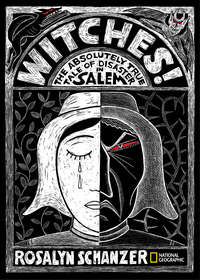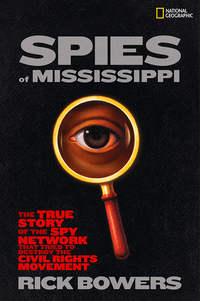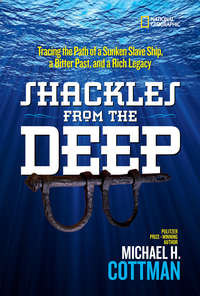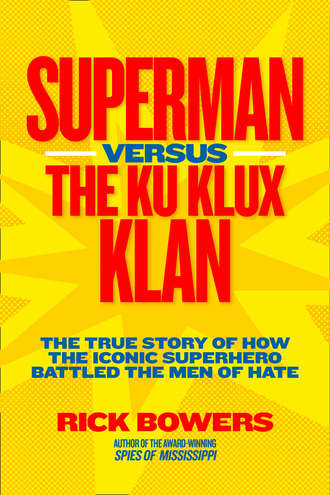
Полная версия
Superman versus the Ku Klux Klan: The True Story of How the Iconic Superhero Battled the Men of Hate
On June 2, 1932, just after closing time, a neighboring merchant noticed that the haberdashery’s door was ajar. The interior lights were on, but Mitchell Siegel was nowhere in sight. The concerned shopkeeper pushed open the door and found Mitchell sprawled on the floor behind the counter—dead. The money in the cash register was gone, as were the three thugs who had robbed him. Initial police reports suggested that Siegel had been shot in the chest and found in a pool of blood behind the cash register. The coroner’s report later amended the scenario: Mitchell had suffered a fatal heart attack during the robbery. Either way, the Siegel family would never be the same.
Jerry’s mother fell into a deep depression. Her message to the children was cold and absolute: Never mention the robbery to anyone. All that the neighbors needed to know was that their father had died of a heart attack. Period. Relatives flocked to Sarah’s side, tried to console the kids, made sure that the bills were paid, and shook their heads over the tragedy. With the Great Depression bearing down, Mitchell’s income gone, and money tighter than ever, the family did the best they could. Devastated by the loss of his dad, Jerry withdrew even more into his science fiction world.
But a fire burned within him. He was more determined than ever to make it in the publishing business. He would work tirelessly to honor the memory of his hardworking father. He had no way of knowing that success was not far beyond the horizon. The shy, grieving, self-conscious, seemingly powerless teen could not foresee that his imagination would conjure up a muscular, all-powerful, super human who could deflect bullets, bend steel in his bare hands, soar into the sky, and protect the little guy from thugs and hoodlums like those who had caused his father’s death.

* CHAPTER 3 *
THE MAGIC OF THE MIX
BY 1934 NEWLY MINTED high school graduates Jerry Siegel and Joe Shuster were operating their own comic art business. While their fellow Glenville graduates were taking introductory philosophy classes on college campuses, operating drill presses in factories, or searching for any work they could find, these offbeat science fiction devotees were pitching their ideas to professional editors and publishers. Fancying himself the business brains of the two-man outfit, Jerry took the lead in managing the enterprise. Concepts for new characters had to be put down on paper and sent out. Push. Letters had to be written to editors and publishers looking for content. Push. Push. Their primary targets were the syndicates that distributed comic strips to newspapers and the companies that were introducing a new kind of publication: comic books.
Jerry and Joe’s story of the Super-Man—that diabolical scientist who conducted gruesome experiments on unsuspecting homeless men—was still incubating in their minds. Then, according to Superman lore, late one night in the summer of 1934, the answer hit Jerry like a lightning bolt. They had it backward. The world had no need for an evil superman. The world needed a good superman—a trustworthy and powerful ally who would come to the rescue of regular people by protecting them from ruthless criminals, cheating businessmen, and corrupt politicians. With millions of people out of work, the streets full of crime, the stock market in ruins, and a war brewing in Europe, readers were starved for hope, inspiration, and a sense of power. A good superman could provide all that.
ACCORDING TO THE LORE, the essence of the character—the one the world would come to know—flashed into Jerry’s mind that restless night with the force of one of those sci-fi meteors crashing to Earth. In point of fact, the epiphany of the good superman sparked a long collaboration that would lead to the iteration of the character known today. The day after the epiphany, Jerry ran to Joe’s house, and the two began evolving the basic story line of the good superman. The next full-fledged version came several months later with the creation of an all-too-human hero the collaborators modestly dubbed “The Most Astounding Fiction Character of All Time!” This superman was strong, agile, and heroic but lacked extraordinary superpowers that would differentiate him from other heroes.
The few publishers who considered the proposal rejected it. Frustrated with the failure, Joe went into a rage and began destroying the manuscript. Jerry intervened but managed to save only the cover. The cover, showing the Superman leaping at a gun-wielding thug, was eerily reminiscent of Mitchell Siegel’s death. Still not quite right. The work continued.
As the writer, Jerry took the lead in developing the now-classic story line that finally emerged. Superman is born on the planet Krypton. His scientist father places him in a small rocket ship and launches him toward Earth just moments before Krypton erupts in devastating earthquakes and explosions that kill all the inhabitants. The spacecraft lands on Earth, where people discover the baby and take him to an orphanage in a small midwestern town. A family named Kent adopts him, gives him the name Clark, and raises him on a farm. After realizing the possibilities of his superhuman powers, Clark moves to the big city of Metropolis and becomes a reporter for a great metropolitan newspaper.
In times of trouble Clark sheds his street clothes and peels off his glasses to become Superman. He uses his powers to leap great heights, to hoist huge weights, to deflect bullets, to soar into the sky, and to subdue criminals. His only motives are to protect the innocent, to bring the guilty to justice, and to crusade for a better world. After saving the day, Superman returns to his guise as the mild-mannered Clark, who works at the newspaper with a gutsy “girl reporter” named Lois Lane. But Lois has little time for bespectacled, nerdy Clark. She only has eyes for Superman.
Sensing that the character was special, the two creators worked feverishly to fill in the details of his persona. Before long the full picture was on the page. Superman had his rugged good looks, his shock of blue-black hair, his muscular physique, his flowing red cape, and the bold S insignia on his chest. Joe designed his uniform as a cross between a spaceman suit and a classic circus performer outfit—down to the blue tights, red shorts, and cape. He skillfully captured each of Superman’s actions in single comic panels: the caped crusader raising his arms toward the heavens, leaping off the ground with incredible strength, soaring upward at supersonic speed, and landing with both feet firmly planted on the ground. The Man of Steel—also called the Man of Tomorrow in those early days—stands tall, hands on his hips, bullets bouncing off his chest, as befuddled, gun-packing gangsters fire shot after harmless shot. In time the classic image would evolve: The handsome, smiling superhero would save Lois Lane from all kinds of danger, hoist her in his arms, soar over the flickering lights of Metropolis, and deliver her safely home.
To breathe life into the Superman character, Jerry and Joe drew upon their love of science fiction, their passion for movies, their fascination for books, and their experiences growing up Jewish during the Great Depression. The Greek and Roman myths they learned at school featured heroes with superhuman strength. Strange visitors from distant planets were common in the science fiction stories they devoured night and day. Daredevil heroes clad in masks and capes were all the rage in the movies they watched at the Crown and the Uptown. Even heroes with dual identities were commonplace on the screen and in print. The silent screen character Zorro was the alter ego of Don Diego de la Vega, a sissified aristocrat who ate, drank, and dressed the dandy to throw off suspicion of his role as the night-riding avenger. The Shadow, a pulp magazine character, was the alter ego of Kent Allard, a famed pilot who fought for the French during World War I. Just as the name Clark Kent was a cross between actors Clark Gable and Kent Taylor, the name of the mythical city of Metropolis came from the 1927 silent film of the same name. For Superman, the magic was in the mix.
Jerry and Joe’s Jewish heritage deeply influenced the makeup of Superman too. The all-American superhero reflected many of the beliefs and values of Jewish immigrants of the day. Like them, Superman had come to America from a foreign world. Like them, he longed to fit in to his strange new surroundings. Superman also seemed to embody the Jewish principle of tzedakah—a command to serve the less fortunate and to stand up for the weak and exploited—and the concept of tikkun olam, the mandate to do good works (literally, to “repair a broken world”). Even the language of Superman had Jewish origins. Before Superman is blasted off the dying planet of Krypton, Superman’s father, Jor-El, names his son Kal-El. In ancient Hebrew the suffix El means “all that is God.”
Then there is the Moses connection. Just before Krypton explodes, Superman’s parents place him in a crib-size rocket and launch him toward Earth to be raised by loving strangers. In the Old Testament, after Pharaoh decrees that all newborn Jewish males be killed, Moses’s mother places him in a crib-size basket and launches him down the Nile River to be raised by others. Just as Pharaoh’s daughter rescues the infant Moses from the bulrushes and nurtures him as her own, the Kents find and raise Superman on Earth. The Superman story also resembles the tale of Rabbi Maharal of Prague, who created his own superman, called the Golem, to protect the people of the Jewish ghetto from hostile Christians.
While Superman was a complex conglomeration of influences, Jerry and Joe left plenty to readers’ imaginations. What Superman wasn’t was just as important as what he was. The character had no clear ethnic background, no hint of an accent or dialect, no stated religious preference, and no political affiliation. The Superman character offered a little bit to everyone. Coming from a distant planet, he was the ultimate foreigner. Raised in the midwestern heartland, he was the quintessential American. Growing up in a small town, he was rural at heart. Moving to a big city, he became more sophisticated and worldly. He was both weak and strong. His meek, mild alter ego, Clark Kent, was a sheepish bumbler, but he was always ready to transform himself into the all-powerful superhero. So Superman was relevant to the prairie farmer, the urban factory worker, the white-collar insurance salesman, the hardworking waitress, and the struggling immigrant. Millions of ordinary people struggling through the Depression could imagine themselves shedding their plain, run-of-the-mill exteriors to reveal their real power within. True, Superman had descended from the heavens with the power of a god. His intention was godly too—to protect humanity from its own worst instincts. But Superman had characteristics the masses could relate to. He could beam with a smile, burst into anger, and form lasting friendships. Beneath it all Superman seemed like a regular guy.
Superman was also a creation of his times. To keep up with those times, Jerry and Joe often spent Saturdays flipping through out-of-town newspapers and national newsmagazines for ideas at the Cleveland Public Library. The headlines described crisis after crisis. The New York Stock Exchange had lost 90 percent of its value. Millions of Americans were out of work. A midwestern drought had engulfed prairie farms in the Dust Bowl, and desperate farmers had to pack up their starving families and head to California to start anew. The international news was no more comforting. Headlines warned of economic collapse in global markets, the rise of fascist regimes in Europe, and the new communist experiment in the Soviet Union. The whole world seemed to be heading toward an explosion.
Despite the challenges, Jerry and Joe found hope in President Franklin D. Roosevelt, who had declared in his 1932 inaugural address that “the only thing we have to fear is fear itself.” The two teenagers liked the sound of Roosevelt’s promise of “a new deal for America.” FDR proposed a series of government programs designed to create jobs, to restore the economy, and to address a range of social ills. In his popular fireside chats, broadcast on all the major radio networks in an era before the invention of television, Roosevelt spoke in plain language that resonated with common men and women. As children of the Depression, Jerry and Joe saw hope in FDR’s pledge to help the average person cope with the “hazards and vicissitudes of life,” to provide some measure of protection “to the average citizen and to his family against the loss of a job and against poverty-ridden old age.” Superman could get behind goals like that.
While FDR had broad public support, fierce critics charged him with either ignoring the national crisis or overreacting to it. Conservative opponents called him a socialist and formed the American Liberty League to derail his welfare programs. Radical opponents wrote off FDR’s relief initiatives as “mere crumbs” and demanded sweeping “share the wealth” programs that involved confiscating the money and property of the rich and redistributing it to the poor. Answering the critics, Roosevelt declared:
A few timid people, who fear progress, will try to give you new and strange names for what we are doing. Sometimes they will call it “fascism,” sometimes “communism,” sometimes “regimentation,” sometimes “socialism …” I believe that what we are doing today is a necessary fulfillment of what Americans have always been doing—a fulfillment of old and tested American ideals.
So Jerry and Joe plucked elements from the world around them to stir into their Superman stew. For the most part, however, Superman’s millions of fans would ignore his origins. For them the Man of Steel would simply be the defender of the little man and woman—and a big problem for the forces of evil in the world.
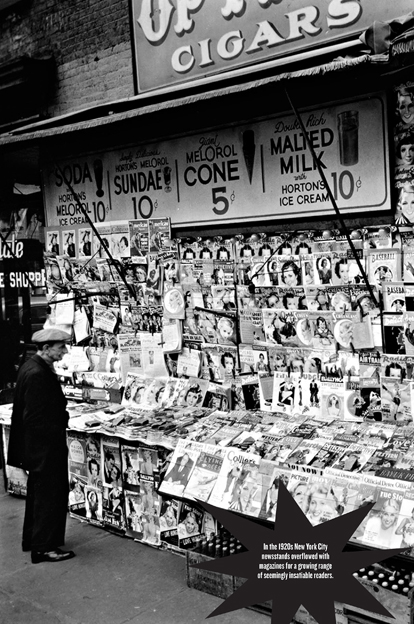
* CHAPTER 4 *
BOOTLEG WHISKEY & PRINTER’S INK
SUPERMAN WAS FASTER than a speeding bullet. His rise to fame was not. The right people would have to come along, and the right circumstances would have to present themselves, before the world could meet Jerry and Joe’s new character. Some 500 miles from Glenville was a place where the optimal conditions for the launch of this new kind of superhero had been brewing—the high-energy world of New York City publishing.
In the early 20th century the Big Apple had changed rapidly from a crass and overpopulated commercial center to the self-proclaimed “greatest city in the world,” and the printed word, photo, and hand-drawn illustration were among its most important commodities. Amid the grit and glamour, clamor and chaos of the bustling sidewalks stood a loosely organized network of newsstands—thousands of gathering places where customers looked through rack after rack of magazines and pulp books covering an ever-expanding range of passions and pursuits. From the offices of the great skyscrapers, visionary publishers launched entire companies dedicated to serving specific slices of readers’ expanding interests and hobbies. From the bowels of the city’s grimy manufacturing hubs, printing presses rolled out a steady stream of books, magazines, and newspapers in currents as strong as those of the nearby Hudson River. For the professional types among the waves of immigrants entering the United States through the halls of Ellis Island, and for their children, the publishing industry represented a chance at getting a thinking man’s job.
The advent of cheap and efficient color printing technology, coupled with car and truck delivery to newsstands and stores, pushed the growth of the publishing business. By the freewheeling 1920s printing presses rolled out vast quantities of titles such as Indolent Kisses and Heart Throbs to True Detective and Time. Ambitious publishers, persnickety editors, creative writers, talented illustrators, and hardworking pressmen served a market of seemingly insatiable readers.
While the disheartening effect of the Great Depression put a damper on the New York publishing trade, the great newspapers, newsmagazines, and popular magazines survived even as their weaker competitors vanished. And even as the quest for profits grew more brutal and the scramble for jobs intensified, New York remained the center of the publishing industry in America. It offered the enterprising entrepreneur an opportunity to run with an idea, to forge a market, and to make a living. The keys to success were twofold: a good idea and a fighting spirit.
In 1933 an out-of-work, would-be publisher and newspaper comic strip aficionado named Max Gaines (he had changed his name from Maxwell Ginzburg to sound less Jewish) came up with one of those good ideas: to take daily and weekly comic strips from newspapers; to arrange them on pages of cheap newsprint; to staple the pages between glossy, four-color cardboard covers; and to market the books to kids. The Eastern Color Printing Company agreed to test Gaines’s concept and produced 35,000 copies of Famous Funnies, Series 1, for distribution as a free promotion to department stores. The entire print run vanished almost overnight, and Eastern rushed Famous Funnies, Series 2, to newsstands. This time the company sold copies for a dime apiece.
Eastern then launched an entire series of comic compilation books without the services of the disappointed Gaines. But the enterprising businessman—showing that fighting spirit—struck a profit-sharing deal with the McClure Newspaper Syndicate and set out to launch a competing line. As Gaines’s new titles became profitable, more publishers began bundling books of comic strip reprints and selling them at newsstands and dime stores. Before long the backlog of available newspaper strips had been exhausted, and existing content for new compilations was scarce.
That’s when the trailblazing publisher of National Allied Publications began hiring new writers and illustrators to create original strips and new characters. Other publishers followed suit. In this wild swirl of competition, the comic book industry began to take shape. Since almost all the major players were Jewish, Jewish writers and illustrators were free to apply for work. This was their chance to start a career in the broader publishing trade. As Jerry and Joe worked on new characters far away in Cleveland, the delivery system for their creations was being built.
By the mid-1930s a short, dapper, well-connected, and highly successful publisher named Harry Donenfeld was contemplating entry into the emerging field. Donenfeld had an appetite for success and the track record to prove it. He knew how to pick titles that sold, hire writers with sizzle, print on the cheap, and, if necessary, muscle his magazines into newsstands, drugstores, cigar stores, barbershops, and beauty salons. Wining and dining wealthy businessmen and powerful politicians at the best restaurants in Manhattan, he spared no expense for his potential clients, influential colleagues, and fun-loving friends.
Donenfeld had made a fortune back in the Roaring Twenties by publishing girlie magazines and racy pulp titles, which had sold as fast as his rackety printing presses could roll them out. With Prohibition in force, Donenfeld had supplemented his publishing profits by transporting stockpiles of bootleg whiskey into New York. He had hid the illegal booze in train cars carrying paper shipments from Canada and sold the hooch to speakeasies across the city, while marketing his magazines and books nationwide. Harry Donenfeld was living the high life—on his terms. His wife Gussie kept their home in the Bronx like a showplace as Donenfeld paraded his girlfriends through the glitziest clubs in town.
But those Roaring Twenties gave way to the Depression, Prohibition was repealed, and the world was far less forgiving of questionable business dealings. Political reformers were looking askance at big shots who cashed in on borderline pornography while millions of decent, out-of-work Americans scrambled to keep from starving. By 1937 New York mayor Fiorello LaGuardia was running for reelection on the promise of shutting down indecent books and magazines, and prosecutors were bringing indictments against risqué publishers. So Donenfeld set out to establish a more legitimate product line. He thought bigger and played harder than anyone else in the fledgling comic book field and figured he could get in on the ground floor and gobble up the profits. The comic book trade was still limited, but the potential for growth was promising. He needed a breakthrough title. He had no way of knowing that two young men in Cleveland had created a character who could provide that kind of breakthrough.
TO MOVE INTO THE COMIC FIELD, Donenfeld turned to his friend, business partner, and spiritual opposite Jack Liebowitz, a no-nonsense, detail-savvy accountant who had grown up in the same Lower East Side, New York, neighborhood as the flamboyant Donenfeld. In contrast to Donenfeld, during those same Roaring Twenties, Liebowitz had studied accounting at night at New York University and had gone to work as a financial manager for the International Ladies Garment Workers Union. He got by on a modest salary while working to win higher wages and better working conditions for immigrants who toiled in crowded sweatshops for 12 to 14 hours a day.
Liebowitz, whose parents had left Ukraine and settled in New York City when he was three, could relate to the hardworking garment makers and believe in their cause. But by the early 1930s, with the Depression bearing down, the striking union out of money, and radical communists attempting a takeover, Liebowitz was more than ready to go into business with a smooth operator from the old neighborhood.
So, the mild-mannered accountant and the back-slapping business tycoon cast their gaze on the emerging comic book business. As the first commercial comic books rolled off the same presses that printed cheap pulp magazines like Ghost Stories, Strange Suicides, and Medical Horrors, Donenfeld and Liebowitz maneuvered for an opening. By 1938 the pair had taken over National Allied Publications and DC Comics (publisher of Detective Comics), thus setting themselves up as major players in the emerging comic book industry.
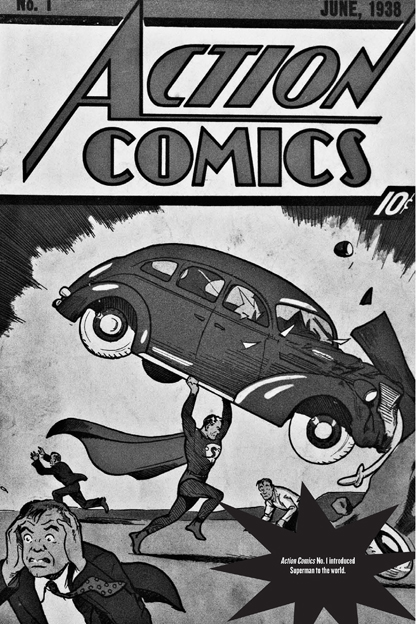
* CHAPTER 5 *
CHAMPION OF THE OPPRESSED
AS THE COMIC BOOK INDUSTRY took shape in New York, Jerry and Joe were eking out a living by operating their own two-man comic business in Cleveland. The aspiring writer and illustrator were living with their parents to save on expenses, working from a makeshift studio in Joe’s attic, and working menial part-time jobs to make ends meet. Having managed to get a couple of contracts with new comic book publishers in New York, the pair developed a few interesting characters. Their title Federal Men featured a wisecracking Federal Bureau of Investigation (FBI) agent named Steve Carson who worked undercover to find kidnapped babies and shut down criminal gangs. Spooky Dr. Occult was a brash, supernatural ghost detective who tracked down zombies, vampires, and other spectral figures. In some episodes the evil Dr. Occult even donned a red cape and took flight as the creators tried out a bit of their Superman material. As the work ebbed and flowed, Jerry and Joe waited for their big break. That’s where Superman was supposed to come in.
At first Jerry insisted on holding back the Superman character from the low-paying comic book publishers in hopes of selling it to an established newspaper syndicate. A major syndicate like King Features or United Features could place a Superman strip in hundreds of newspapers nationwide and generate thousands of dollars in royalties in the process. A portion of the royalties would go to the creators week after week, month after month, year after year, for the life of the strip. Strips like Little Orphan Annie and Popeye had been popular in newspapers for years, and their creators were dining at the top of the comic-art food chain. But the strategy of saving Superman for syndication had produced only a drawer full of rejection letters from syndicate executives, who claimed that an all-powerful being from another planet, dressed in tights and serving the public good, was too far-fetched for a broad newspaper audience comprised mostly of adults. One editor from United Features indelicately summed up Superman as “a rather immature piece of work.”




